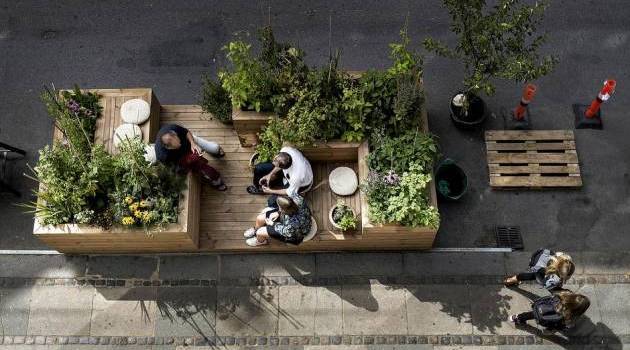Critical Comment about URBEGO Urban Pockets
By Anni
In my opinion URBEGO Urban Pocket is a nice urban
project with a good concept behind it. The idea of the URBEGO Urban Pocket not
only offers a cost-effective strategy of creating and maintaining community
open spaces, but due to its co-creation approach, it represents an effective
way to address some of the problems of urban living, such as isolation and
social exclusion, by enhancing local identities and sense of belonging to a
common place.
But they didn’t invent a new idea- there are already a
lot of pocket parks all around the world. Pocket parks stand for open spaces in
a very small scale which are usually raised by community groups or foundations.
They are normally created on vacant building lots, small irregular pieces of
land or neglected communal spaces.
 One of the first pocket parks is the very popular
Paley Park created by Zion and Breene Associates. It was finished in 1967 for
the William S. Paley Foundation. This open space on private grounds is successful
for many reasons. It is located on a
good spot so that the local community (and tourists) is maintaining the park.
The movable tables and comfortable chairs guaranty a pleasant feeling, as well
as the shading under the trees and the waterfall. That is also good for the
noises around which get drowned out by the sound of the water.
One of the first pocket parks is the very popular
Paley Park created by Zion and Breene Associates. It was finished in 1967 for
the William S. Paley Foundation. This open space on private grounds is successful
for many reasons. It is located on a
good spot so that the local community (and tourists) is maintaining the park.
The movable tables and comfortable chairs guaranty a pleasant feeling, as well
as the shading under the trees and the waterfall. That is also good for the
noises around which get drowned out by the sound of the water.
Another example of a pocket park is a project by VEGA
landskab, which was drafted in 2012 in Copenhagen. This project is sited in an area of heavy pedestrian traffic so that
they are visible.
 My third chosen project is
located in Japan, in the city of Kumamoto and was built in 2014. The
‘kikuchi pocket park’ is a plan of three parks designed by Japanese architect Takao
Shiotsuka of takao shiotsuka atelier. Two of
those three drafts are already finished. This example ‘kiriake’, is a miniature
water park supplied by an agricultural waterway. The water appears to have been
collected within three large puddles scattered upon the plot. A lavatory,
shelter and bench formed by abstracted stone structures are interconnected by a
consistent white paver, evoking the sand of a Japanese rock garden.
My third chosen project is
located in Japan, in the city of Kumamoto and was built in 2014. The
‘kikuchi pocket park’ is a plan of three parks designed by Japanese architect Takao
Shiotsuka of takao shiotsuka atelier. Two of
those three drafts are already finished. This example ‘kiriake’, is a miniature
water park supplied by an agricultural waterway. The water appears to have been
collected within three large puddles scattered upon the plot. A lavatory,
shelter and bench formed by abstracted stone structures are interconnected by a
consistent white paver, evoking the sand of a Japanese rock garden.
In conclusion, all the great working pocket parks in
the world achieve some important points. It is easier to create a pocket park
than to maintain it. Most significant is the support of the community, as well
as the need of using and maintaining. Furthermore the attention should focus on
a functional design, otherwise the new created pocket park may fall into disrepair
faster than it was raised.


No hay comentarios:
Publicar un comentario